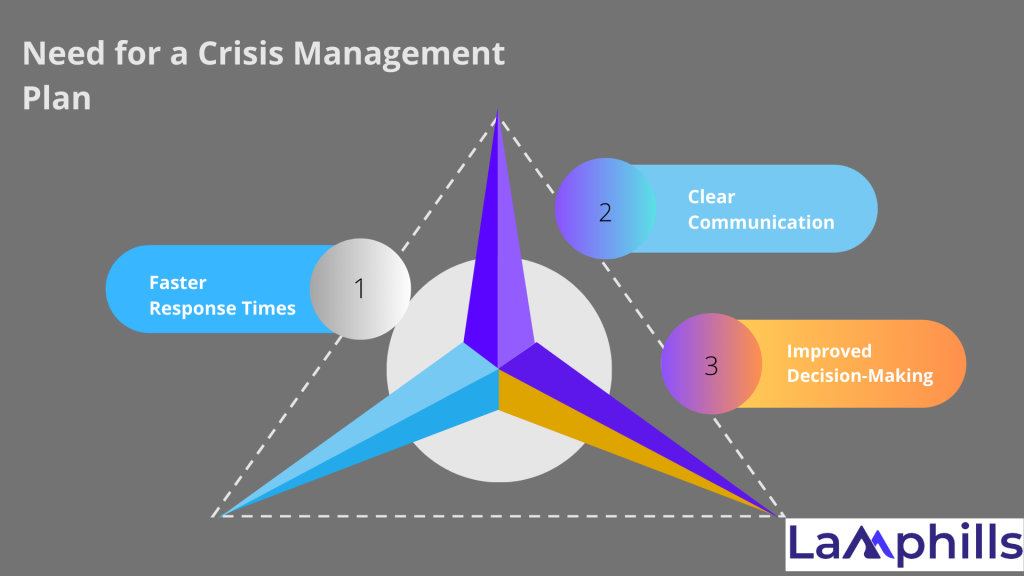These days, nobody likes to consider the worst-case situation. Being a business owner is more than just praying for sunshine and rainbows. But, with a crisis management plan, it’s about being ready for the occasional winds – or perhaps a full-fledged storm.
As a child, I used to see my father fix everything around the house. No matter what happened, he always appeared to know what to do. A burst pipe, a flickering light, or even a fallen tree branch in the backyard—he’d take his gear and set to work. As I grew older, I learned that his calmness was as important to his success as his skill. He never panicked, regardless of the commotion. Little did I know how important this approach would be in my job as a crisis manager now.
Let me tell you about the time I had to deal with a huge data breach at a technology company. The breach exposed sensitive information and it seemed as if the entire organization was on the verge of collapse. I was called in because they needed someone to navigate the storm and restore order to the chaos. At first, it felt overwhelming. The phones wouldn’t stop ringing, the media gathered outside our facility, and staff were concerned about their jobs. But, like my father with his toolkit, I had to remain calm and focused on the task at hand.
In crisis management, you do not always get to pick your battles. According to a PwC survey, 69% of business leaders have faced at least one crisis in the past five years, with 95% expecting another soon. That’s the nature of the job: unpredictable and unrelenting. You cannot prepare for everything, but you can prepare for the majority of them.
So, join me on this journey as I share my insights on developing an effective crisis management plan for your business, from the why and how to what goes into a solid plan, the steps to creating one, and even some real-life examples of businesses that weathered crises with a well-defined CMP by their side.
Make the checklist downloadable
Key Points
- Crisis management isn’t something to put on the back burner. By identifying potential crises, assessing risks, and understanding their impact on business operations, you can proactively prepare for the unexpected.
- Effective crisis management hinges on clear communication. Establishing communication protocols, assembling a crisis management team, and defining roles and responsibilities ensure everyone knows what to do when crisis mode kicks in.
- Building an effective crisis management plan isn’t a one-and-done task. Regularly reviewing and updating the plan, conducting training sessions, and testing through drills and simulations help identify weaknesses and areas for improvement.
- There’s plenty to learn from both personal experiences and case studies of other businesses’ approaches to crisis management. Analyzing successes and failures can provide valuable insights and best practices to apply to your plan.
What is a Crisis Management Plan?

Image by pch.vector on Freepik
A crisis management plan (CMP) outlines how your company handles a crisis, including who will be engaged and what they will do. The plan is to minimize damage and resume activities as quickly as possible. Your crisis management strategy is a dynamic document that your team may regularly refer to and update. There are other ways to structure your strategy, but a basic crisis plan resembles a checklist. So that when mishaps occur, your team can cross off the actions that must be completed to respond to the situation.
However, there is no way to predict what type of crisis will come and when doing a risk analysis can provide you with a broad picture of the potential hazards your firm might face.
A social media marketing company, for example, maybe more vulnerable to an organizational error that necessitates a public apology. In comparison, a tech corporation may be more vulnerable to a cyberattack. This means the industry you work in can also help you identify possible crises and plan how to deal with them.
Understanding the Need for a Crisis Management Plan

A recent PwC survey shows 95% of company leaders expect to experience a crisis shortly. However, only 23% of firms believe they are fully prepared for such events. Crisis management plans are designed to bridge the gap between expectations and readiness. A good CMP enables you to predict problems, respond effectively, and recover with minimal damage.
One of the most eye-opening experiences in my work came when a client’s factory caught fire. Everyone knew what to do; they had practiced the evacuation plan, and everyone got out safely. But what happens in the aftermath? This is where most crisis management strategies fall short: what happens after the initial response? Our CMP contained thorough recovery measures for not only business operations but also employee well-being and community relations. It made an enormous impact.
So, why is a CMP so important? The truth is that crises aren’t an issue of “if” but “when.” Now that I think about it, crises occur in a variety of sizes. It might be anything from a data breach that exposes customer information (as happened to Target in 2013 and cost them $20 million) to a disgruntled employee publishing unfavorable reviews online. Even a natural disaster, such as a power outage or a burst pipe that floods, can impede your operations and ruin your brand.
Here’s the good news: having a CMP in place can significantly reduce the financial and reputational damage caused by a crisis. Here’s how:
#1. Faster Response Times
When a crisis hits, the clock starts ticking. But a CMP ensures you have a clear plan of action, allowing you to respond quickly and efficiently. This in turn minimizes confusion and helps you regain control of the situation.
#2. Clear Communication
A crisis can easily lead to panic and misinformation. A CMP ensures you have a designated spokesperson and a well-defined communication strategy, allowing you to deliver clear, consistent messages to all stakeholders, both internally (employees) and externally (customers, media).
#3. Improved Decision-Making
When emotions are running high, making sound decisions can be challenging. A CMP provides a framework for clear-headed decision-making, ensuring you take the right steps to mitigate the crisis and protect your business.
Crisis management is an essential part of any business plan because, without it, your team won’t be prepared when the unexpected happens.
Furthermore, a crisis management plan prepares an organization to deal with an unexpected disaster in the following ways: it reduces and lessens the impact of a crisis; it protects employees and anyone else affected; it preserves operations and productivity to the greatest extent possible; and it protects a company’s reputation.
Key Components of a Crisis Management Plan
Now that we’ve established the “why” behind a plan, let’s dive into the “what.” Here are the essential key components of a strong plan. So, your crisis management plan should include the items below.
#1. Technology and Data Security
In a Forrester analysis from 2023, 78% of firms felt that AI and data analytics are critical for crisis management, but only 45% actively employ these technologies in their CMPs. This means integrating technology into your crisis plan can help you anticipate potential problems and enhance reaction times. During a cyberattack situation that I oversaw, we used sophisticated analytics to immediately identify the source of the intrusion, allowing us to reduce data loss and communicate with stakeholders more effectively.
#2. Risk Analysis
Outline the circumstances you believe your firm may face. That is, having a more specific understanding of these potential events can help guide your planning. , You do not need to list every possible risk, but rather a broad range, such as a natural disaster, a cyberattack, a utility outage, a technology failure, the death of a CEO, a workplace shooter, a financial crisis, an operational accident, and a product failure.
#3. Activation Protocol
Make sure you include triggers in your crisis management strategy, as the natural initial reaction to an emergency is frequent paralysis. Thereby, using urgency as a criterion, to establish the circumstances that trigger a certain crisis reaction.
Additionally, describe how to escalate that reaction if a crisis turns out to be more serious than it first appeared. Based on the type or location of the incident, the protocol should also direct your staff on how to respond. And, the protocol should establish some type of communication that signals the end of a crisis.
#4. Emergency Contacts
Include the key emergency contact information to quicken the response time for problems that necessitate outside assistance. Local law enforcement, hospital first responders, and the fire department, as well as plumbing, electrician, poison control, and any other services connected to the dangers identified in your study, should be on your emergency contact list.
#5. Procedures for Responding
While an activation protocol specifies when your crisis response team should respond to a crisis, response procedures explain each person’s action plans when activated. A roles and responsibilities matrix, also known as a RACI chart, can help you explain the decision-making positions in your crisis response strategy. For example, a RACI chart can enable the reaction team to determine who’s accountable for communicating with the public and who’s responsible for talking to employees.
#6. Resources
Consider everything the crisis management team would require, from hard helmets to credit cards and a backup public relations expert, and arrange these items. Information resources will be critical during a crisis. These resources include a variety of stakeholder agreements, such as union contracts, facility maps, timeframes, flowcharts of essential processes and procedures, supplier contracts, benefits information, and more.
#7. Training
It is critical to be able to execute your crisis management strategy rapidly, and conducting drills and exercises with the crisis management team will help you achieve that aim. Rehearsals or even tabletop exercises can identify problems in the plan, and practice will allow the crisis team to get more comfortable with their duties and collaborate. Ensure that you stay updated by completing frequent training.
In addition, provide training to other staff members based on their particular jobs, such as showing a warehouse manager how to use a fire extinguisher, explaining to a production associate how to stop an assembly line, or teaching an executive assistant how to respond to a media phone call.
#8. Internal Communication Plan
Create systems and backup methods for the crisis management team to communicate with one another. Collect contact information for all team members and anyone else they may need to contact, such as outside consultants and subject matter experts. You must also build methods for communicating urgent information to all employees, such as using a notification provider to send texts and automated calls or implementing a system for your staff to check in and report their safety and locations. Determine how you will communicate sensitive information internally, such as a threat to the company’s viability or a loss of life. Don’t forget also to provide a timetable and method for updates.
#9. External Communication Plan
Develop strategies for communicating with the general public and key external stakeholders. Choose a representative. Write clear directions, indicating who will be notified (for example, media outlets in a certain geographic area).
Also, create draft holding statements that you may fill out later after you have the necessary information. Determine your strategic communication goals and establish talking points. Make sure your plans are consistent with other forms of communication. Prepare to set up a dedicated website or phone line to answer consumer or community questions.
#10. Review
After a crisis, it’s tempting to sigh and go on. However, now is the time to learn and grow. According to a Harvard Business Review research, 74% of organizations do not conduct a thorough post-crisis analysis, resulting in the loss of key information. Throughout my career, I’ve discovered that the most effective crisis management plans are those that grow depending on experience and lessons learned. Following each crisis, we perform a thorough study, asking what worked, what did not, and how we may improve in the future.
Create a structured review procedure to arrange regular follow-ups on your plan. Your crisis management plan must be updated as your business or risk environment evolves. After a crisis, the team should analyze what went well and what did not. Identify important lessons, and implement any necessary changes.
Steps to Building an Effective Crisis Management Plan
Alright, buckle up because we’re about to get into the main business of the day. Building a crisis management plan is something you can only put together after a while. It takes careful planning and consideration. First things first, conducting a thorough risk assessment is paramount.
This involves looking at everything from natural disasters to cybersecurity threats and everything in between. Once you’ve identified your potential pitfalls, it’s time to set some clear objectives and goals. What do you hope to achieve with your crisis management plan?
Keep these goals in mind as you move forward.
#1. Assess Possible Risks
Before you get too far into crisis preparedness, sit down with your team and discuss potential hazards. While some risks are prevalent across industries, the relative frequency and risk level will differ depending on your industry and firm.
You might start by looking for a crisis management plan sample for your sector. However, you must come up with ideas to identify additional hazards and tailor the sample strategies to your specific firm. Remember to consider incidents such as these:
- Extreme weather events
- Cyberattacks
- Product recalls
- Social media mistakes
- Public relations blunders
- Workplace issues
During this stage, get feedback from as many people and tools as feasible. danger registries, for example, can assist you in determining the likelihood of a specific danger. Ideally, you should rank the crises based on probability and severity so you know which ones to put first in your strategy.
#2. Establish a Crisis Management Team

I’ll never forget the first time I had to gather forces amid a crisis. It was crazy, to say the least! That’s when I learned how important it is to form a dedicated crisis management team. These are the ones who will have your back when things go difficult.
Similarly, think of your CMP team as your company’s superhero squad. This devoted group of people will be in charge of guiding the reaction to a catastrophe. Here are some critical roles to consider:
- Team Leader: The captain of the ship, this person oversees the entire crisis response effort.
- Spokesperson: The voice of the company during a crisis, responsible for communicating with the media and the public.
- Communication Specialist: The wordsmith who crafts press releases, social media messages, and other communication materials.
- Legal Counsel: Ensures you comply with all legal regulations during a crisis.
Additional Roles: Depending on your business size and industry, you might also want to include representatives from IT, HR, or customer service.
#3. Determine the Impact on Your Business
Return to your previously generated list of probable business risks. Consider each one’s possible impact on your firm. Also, remember to assess each risk independently, as they might all result in various results. Some potential business implications to be aware of include the following:
- Regulatory fines
- Reputation damage
- Customer attrition
- Delayed sales
- Lost income
If you aren’t sure where to start with this, look for a business impact analysis (BIA) template online and see how it applies to your business.
#4. Plan Your Responses
The most important step in learning how to construct a crisis management plan is to develop your company’s crisis response strategy. This is the time to consider what steps you will take if the threat arises.
For example, one aspect of your cyberattack strategy could be network security. Meanwhile, another staff member could inspect the damage, while another could notify your consumers. A social media blunder’s CMP could also entail releasing public remarks and informing customer support representatives.
Once you’ve planned your basic response, it’s time to get into more detail. Your crisis management plan begins with a written (or even verbal) approach, but it continues beyond that. You must include emergency contact information and an activation mechanism. You also need to get input from key stakeholders, who need to be kept in the loop during the crisis. Don’t forget to check relevant regulatory requirements as you plan your response.
#5: Train Your Team and Test Your Plan
The other steps in crisis management will be ineffective if everyone does not understand their roles. Remember that in the absence of clear instructions, panic, and stress might cause employees to temporarily forget their training or instructions.
So, begin by making the plan and the crisis management document you produced easily accessible. It can also be quite beneficial to use a crisis management tool that provides real-time access to contact lists, current documents, event reporting, and other resources.
More significantly, you should train your stakeholders and staff on the plan. Schedule regular exercises or rehearsals to ensure that everyone is accustomed to the plan. This reduces the chance of someone being overwhelmed during a crisis and forgetting their duty or where to find the relevant information.
#6. Review and Get Feedback
Your crisis response strategy needs to be reviewed and updated regularly. One of the finest times to do this is just after a catastrophe happens. A post-crisis assessment is the greatest way to determine what worked well in the strategy and what didn’t. This will help you make adjustments to enhance future responses.
As a result, every member of your crisis management team should examine the CMP to verify that it is comprehensive and does not overlook any potential risks or actions. This is the moment to solicit feedback from other stakeholders, specialists, and anybody else involved in the strategy. Remember to review your crisis management plan frequently. This allows you to keep it up to date as your firm and possible threats evolve.
#7. Have A Business Continuity Plan
A business continuity plan (BCP) describes how you will resume operations if an unforeseen event affects your routine business activity. A CMP focuses on managing the immediate crisis and communication, whereas a BCP focuses on putting your business back up and running as soon as possible. Consider merging your CMP and BCP to create a holistic response strategy.
Case Studies and Examples of Effective Crisis Management
To drive home the importance of having a solid crisis management plan, let me share a couple of real-life examples. Take
#1. Johnson & Johnson’s Response to the Tylenol Tampering Crisis (1982)

Johnson & Johnson’s management of the Tylenol poisoning crisis in the 1980s This horrible episode involves the cyanide manipulation of Tylenol pills, which resulted in multiple deaths. rather than ignoring the problem, they acted quickly, recalling millions of bottles and introducing tamper-proof packaging. Their candor and prompt response not only saved lives but also helped to maintain their reputation in the long run.
#2. Southwest Airlines CEO Gary Kelly

Another example is Southwest Airlines CEO Gary Kelly’s response to the death of a passenger on Flight 1380, which demonstrated the company’s sincere grief and dedication to assisting the impacted passengers and families.
On the other side, United Airlines’ initial reaction to Dr. David Dao’s forcible removal from a flight was severely criticized, leading to negative social media reactions and calls for a boycott. The company later accepted responsibility and outlined changes being implemented to prevent similar incidents in the future. These examples demonstrate the significant impact that effective crisis management can have on an organization’s reputation and overall success.
#3. Chipotle’s Response to E. Coli Outbreaks (2015-2018)

A string of E. coli outbreaks connected to Chipotle restaurants sent shockwaves through the fast food industry. Chipotle responded by temporarily closing affected stores, enforcing tougher food safety measures, and launching a huge marketing blitz to reassure consumers.
These are only three of several examples of how a well-defined CMP may make a huge difference during a crisis. By analyzing these success stories and applying best practices to your strategy, you can prepare your firm to weather any storm.
What are the 5 Ps of Crisis Management?
The five P’s of crisis management are prediction, prevention, preparation, performance, post-action, and assessment. This paradigm entails attempting to eliminate uncertainty from the future by updating inputs, gathering intelligence about potential threats, identifying potential targets, and understanding weaknesses.
What Are The Six Stages of a Crisis Plan?
The six stages of a crisis plan are Warning, Risk Assessment, Response, Management, Resolution, and Recovery.
What Are The Key Benefits of a Crisis Management Plan?
Having a Crisis Management Plan provides numerous benefits, such as identifying threats, minimizing the likelihood of damage, improving response, protecting employees, preserving operations, and safeguarding reputation.
How Often Should a Crisis Management Plan Be Reviewed and Updated?
It is recommended to review and update the Crisis Management Plan at least annually for optimal effectiveness.
Conclusion
An effective crisis management plan is like a living document, evolving and adapting to your organization. It’s more than just responding to a crisis; it’s also about planning for the unexpected and learning from every event. But, by concentrating on the often-overlooked components of a CMP, you can devise a strategy that not only helps you survive but also prosper in the aftermath.
Keep in mind that a crisis is not an “if” but a “when situation.” But by being proactive and developing a robust CMP, you can ensure that your company emerges from any difficulty stronger and more resilient.
References
- asana.com
- podium.com
- smartsheet.com
- saferwatchapp.com






